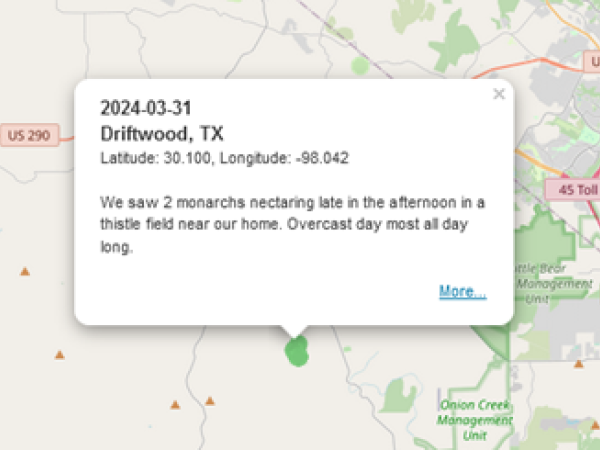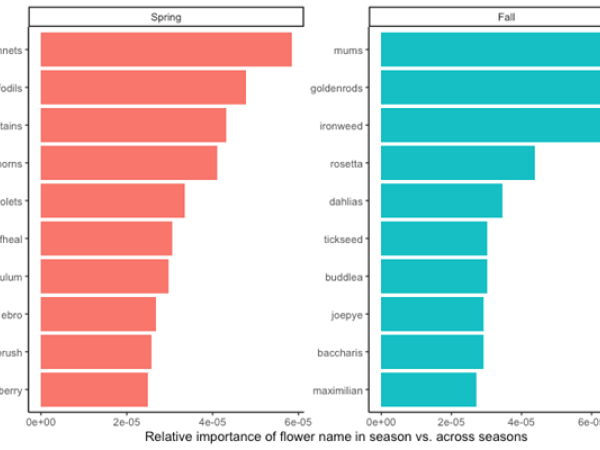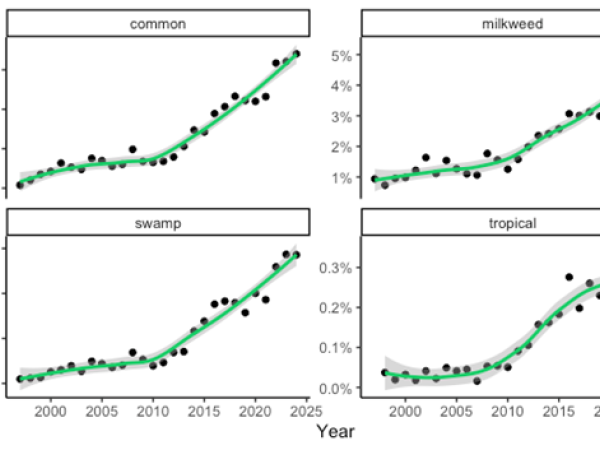Volunteer comments yield clues about monarch behavior and migration
Why work with volunteer comments?
As of May 1, 2024, Journey North observers have submitted 302,865 monarch sighting reports. Journey North reports are submitted online and include accounts of when and where observers saw monarch butterflies, caterpillars and eggs, as well as milkweeds, the monarchs’ critical host plant. Of the total number of reports from 1996 to 2024, 289,637 submissions included text-based comments in addition to the location, date, and type of observation. Typically written as two or three-sentence narratives, these comments contain tiny stories of curiosity and discovery, and rich information about monarch behavior, habitat use, appearance and condition.
As a graduate student who is collaborating with Journey North to better understand trends in monarch migratory behavior, these comments represent a valuable resource for my research. I work in Dr. Sonia Altizer’s lab at the University of Georgia, and my research brings together Journey North observations, mathematical modeling, and field studies to focus on monarch migration and residency, monarch behavior, and disease risk. By unpacking descriptive information from Journey North comments, I can get a detailed picture of what monarchs are doing and the habitat they’re doing it in, which might be relevant to monarchs’ health, migratory success and exposure to parasites.
A few early findings
Sorting through nearly 300,000 comments one at a time would take a very long time and might not result in high-quality, reproducible information. If you’ve ever been in a book club, you know that two people can read the same text and come to very different conclusions about what it all means and what elements are most important.
Fortunately, we can use tools like computational text mining and natural language analysis methods to transform observer comments into quantitative data for more systematic analysis. One simple method is to count the number of times each word is used across all contributed comments. As illustrated in the word cloud below, the most common word that people use is, unsurprisingly, ‘monarch.’ Other commonly used words relate to monarch behavior (laying, nectaring) and habitat use (milkweed, tree, garden), or to the act of observation itself (saw, spotted, found).
A slightly more sophisticated method is to compare how often a word is used within a specific group of observations vs. how often it’s used in general. Using this approach, I search volunteer comments for signals of differences in monarch behavior and ecology that people observe in different places or at different times of year. For instance, when I compared the relative use of different plant species names in the spring and fall, I found that observer comments recorded in the Spring are more likely to include the names of plants like blue bonnets, daffodils and violets. In fall, observations are more likely to mention mums, goldenrod, and ironweed. These differences add extra context to dates and locations, highlighting how habitat and resource availability change throughout the year.
Taking a longer view, we can study trends across multiple decades of Journey North observations. Since 2010, it appears that observers have been increasingly motivated to identify milkweed species in their reports. This trend in observations could reflect growing awareness of the importance of milkweeds as host plants that support monarch reproduction and of the ecological differences between native and introduced milkweeds in North America.
In the future, I plan to use information from Journey North comments to classify monarch behavior during each observation into categories like “nectaring,” “flying,” “mating” or “roosting.” Using this analysis, I hope to learn about how monarchs are using specific habitats and resources for migrant stopovers, overwintering, and reproduction, as well as how monarchs’ annual migratory cycle might be changing in response to factors such as temperature and urbanization.
Journey North thanks all volunteers who have submitted comments through the years. If you are observing monarchs and milkweed, please report to Journey North, and don’t forget to comment!
Charlotte Hovland is a master's student in Dr. Sonia Altizer's lab at the University of Georgia Odum School of Ecology. For her graduate research, Charlotte is studying changes in monarch migratory behavior in the Southeast, including residency and coastal overwintering, in collaboration with Journey North and the MOVERS (Monarch OVERwintering in the Southeast) Working Group.

Sample comment

Word cloud

Relative importance of flower names

